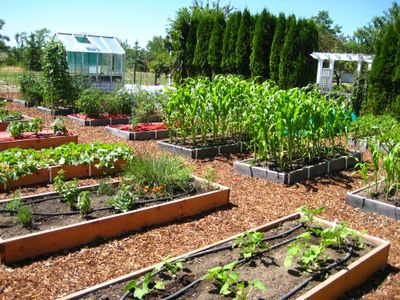Growth spurts
Preparation pays off as garden begins to produce

It’s time for the monthly update on how my garden is coming along. Harvesting the veggies regularly is my primary focus now. It can be tedious, but if I think ahead to how delicious my preserved produce will taste in the dead of winter, I know the effort is worth it.
As you can see by the photo, the garden has really kicked into high gear thanks to our warm, sunny days. Besides harvesting, I’m monitoring the garden daily for any problems.
Of all the vegetables in the garden, the Italian pole beans win the prize for production. The plants are more than 7 feet tall and are producing an abundance of wide, flat beans that average 10 inches in length. Beans should be picked on a regular basis – about every three days – so they will keep producing. The Jacob’s Cattle Bean plants are covered with pods full of shelling beans that I’ll harvest when the pods become brown and brittle.
The Alaska hybrid cantaloupe plants have more than a dozen developing melons on them so I have pinched back all of the vines to force the plants to mature them. Winter squash vines get the same treatment. Zucchinis and other summer squash should be harvested when they are small and tender; don’t let them get as big as a baseball bat.
The Silver Queen corn is about 6 feet tall and starting to tassel. Because I plant them in blocks, the pollen from the tassels can easily pollinate each ear. Once the silks sticking out of the ears are brown and dry, the ears are ready to pick.
Our tomato plants have grown a lot over the past month but our cool spring weather will likely effect production. I’m keeping an eye on the plants for stems that have been stripped of their leaves, a sure sign of tomato hornworm damage. If there are worms, I’ll just hand-pick them off the plants. It’s also time to start pruning back the tips of the tomato plants to force them to start ripening the existing fruit.
The potato plants have a thick mulch of grass clippings around them to help the soil retain moisture and keep weeds down. But the mulch plays one other important role: it keeps potatoes growing at the soil surface from getting exposed to sunlight. If that happens, the potatoes will turn green and develop a harmful substance called solanine. The potatoes still are edible, provided you trim off the green portions, but heavy mulching or hilling up the plants with soil will prevent this from happening.
Our garlic is ready to be harvested. How do I know this? When the second leaf from the bottom of the stem turns brown, it’s time to pull the plants and move them to a dry area out of the sunlight so they can cure a bit before being stored. Onions get a similar treatment. When the stalks start falling over, that’s a sign that they’ve finished growing. This is the time to stop watering them. When the stalks have dried up, carefully pull up the bulbs and move them to a dry, shady area to finish curing before they go into storage.
I learned a good tip from a friend this week. He provides a horizontal wire support for his eggplants to grow up through because the fruits get very heavy while they’re developing. I’m going to note that in my garden journal for next year.
I hope your garden is doing well and providing you with an abundance of delicious produce.